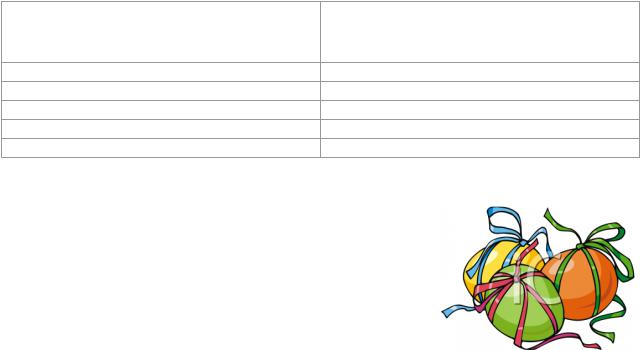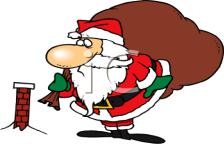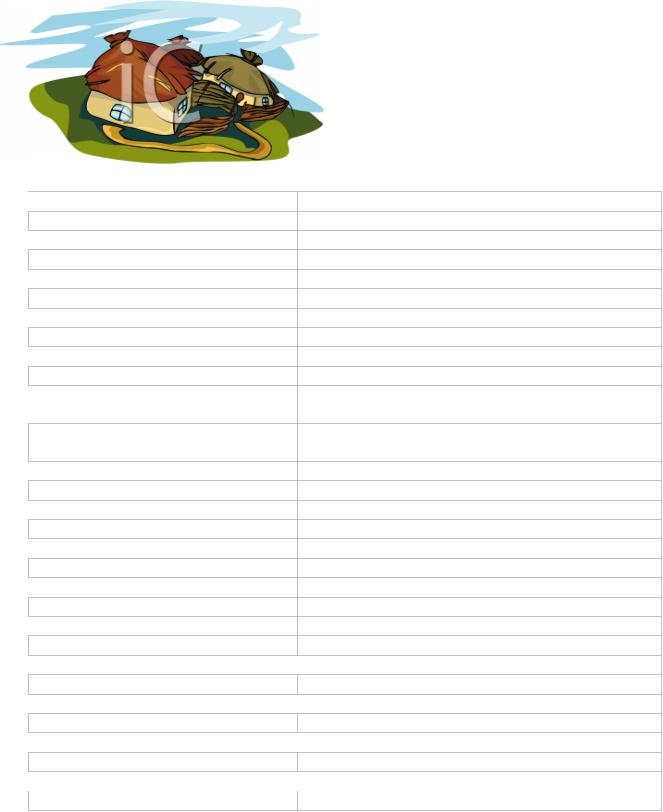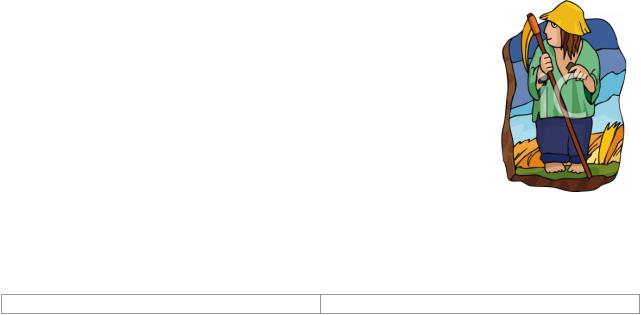
Beginner one-piece
.pdf
LESSON 14
Holidays and Traditions
Christmas comes but once a year. He who has not Christmas in his heart will never find it under a tree.
One of the most glorious messes in the world is the mess created in the living room on Christmas day.
Traditions are group efforts to keep the unexpected from happening.
An optimist is a person who starts a new diet on Thanksgiving Day.
TOPICAL VOCABULARY |
|
|
|
|
1. Ukrainian religious holidays and |
1. Українські релігійнісвята |
татрадиції |
||
traditions |
|
|
|
|
to celebrate |
святкувати |
|
|
|
wedding / birth / burial rites |
весільобряди/ нарі/ брядидження |
|
|
|
|
поховання |
|
|
|
young / married couple |
молодаодружена/ пара |
|
|
|
secular |
світський, мирський |
|
||
Lent / fasting |
Великийпістпіст/ |
|
|
|
to bless(ed) / blessed food / to bless |
благосло,освячув/ їжлятиячена/ |
|
|
|
oneself |
хреститися |
|
|
|
crucifixion / resurrection / purification |
розпинанняхре;муки,стражданняі |
|
/ |
|
|
воскресінняз(мертвих) |
|
|
/ очищення |
Easter / Easter bread / Easter egg / Easter |
Великдень, Пасха / паскакрашанка/ писанка( ) / |
|||
basket / Easter mass |
пасхальнийкошик/ службахальна |
|
|
|
Shrovetide (Pancake Festival) / pancake |
Масляна / млинець |
|
|
|
April Fool’s day |
Деньсміху |
|
|
|
2. Christmas (X-mas) |
2. Різдво |
|
|
|
to sing (sang; sung) X-mas carols |
співатиріздвяніколядки |
|
|
|
chimney / mistletoe |
димар / омела |
|
|
|
Christmas Eve |
вечірнапередодніРіздва |
|
|
|
reindeer / sleigh (sledge) |
північоленьий |
/ сани |
|
|
3. Valentine’s Day |
3. ДеньСвятогоВалентина |
|
|
|
to express(ed) feelings |
висловлювати (виражати) почуття |
|||
to exchange(d) gifts |
обмінюватисяподарунками |
|
|
|
to go (went; gone) out on date |
ходитинапобачення |
|
|
|
heart-shaped card |
листівкауформісерця |
|
|
|
candle-light dinner |
вечерязісвічками |
|
|
|
4. Halloween |
4. Гелловінперед( |
|
деньусвятихіх) |
|
scary costume |
страшнийкостюмубрання( ,щолякає) |
|
|
|
carved pumpkin / jack-o’-lantern |
вирізанийгарбузліхтар/ ,вставленийугарбуза |
|
|
|
to play(ed) tricks |
жартувати,обдурювати |
|
|
|
‘trick or treat’ |
“цукеркиабосмерть! |
|
” |
|
5. Foreign holidays |
5. Іноземнісвята |
|
|
|
Bank holidays |
банківськісвятауВеликійБританії |
|
|
|

Memorial Day (Remembrance Day) / |
Деньпам |
’ятіДень/ ветеранів |
Veteran’s Day |
|
|
Independence Day |
Деньнезалежності |
|
Thanksgiving Day |
Деньподяки |
|
Labour Day |
Деньпраці |
|
INTRODUCTORY TEXT
Home and Foreign Holidays and Traditions
Notes to the text:
to celebrate(d) – святкувати public holiday – державнесвято huge – великий
joyful – радісний
to stay awake – неспати
to be associated with – бути пов’язаним iз
service – службацерковна( )
greetings of affection – вітання любові Pancake day / pancake – Масляна / млинець turkey – індичка
pumpkin pie – гарбузовий пиріг
to keep up traditions – дотримуватися традицій
Every nation and every country has its own customs and traditions. But there are also international holidays which are celebrated practically in all the countries. They are: Christmas, New Year, Easter and St. Valentine’s day.
Christmas is a traditional family day. On this day, many people go to church, open their presents and eat a Christmas dinner. In Britain Christmas is the most important public holiday of the year. Every year a huge Christmas tree is placed in Trafalgar square. In Ukraine Christmas is celebrated on the 7th of January. On this day people celebrate the birthday of Jesus Christ.
Year is a public holiday. It is not so important in Britain and America, but it has a joyful celebration in Ukraine. People stay awake until midnight on December 31st. Many parties are given on this night. Restaurants, night clubs and streets are crowded.
Easter is one of the most important Christian holidays. It is traditionally associated with Easter eggs and with the coming of spring. Most churches are specially decorated with flowers for the service.
St. Valentine’s Day is not the official holiday in most countries. February 14th is the day of lovers. Boys and girls, sweethearts and lovers, husbands and wives, friends and neighbours exchange greetings of affection, saying: “Be my Valentine.
There are also some special holidays which are celebrated in a particular country.
Let's start with the traditional British holiday Pancake Day. But people don't only eat pancakes on this day, they run with them. In many towns in England pancake races are held every year.
The truly American holiday is Thanksgiving Day. Thanksgiving is a day when the family eats a large traditional dinner, usually with turkey and pumpkin pie.
In Ukraine we celebrate Women’s day on the 8th of March. On this day men do everything about the house and cook all the meals.
Ukrainians and Englishmen are proud of their traditions and carefully keep them up.
1.Comprehension questions.
1.What are the international holidays?
2.What is the difference between Christmas in Britain and Ukraine?
3.What holiday is associated with eggs and the coming of spring?
4.When do people exchange greetings of affection?
5.What is Pancake Day?
6.Where and how is Thanksgiving Day celebrated?

2. Complete the sentences. |
|
1. |
On ………., many people go to church, open their presents and eat a holiday |
|
dinner. On this day people celebrate the birthday of Jesus Christ. |
2. |
………. is not so important in Britain and America, but it has a joyful celebration |
|
in Ukraine. |
3. |
Most churches are specially decorated with flowers for the service on ………. . |
………. is the day of lovers. |
|
4. |
But people don’t only eat pancakes on ………., they run with them. |
5. |
On ………. the family eats a large traditional dinner, usually with turkey and |
|
pumpkin pie. |
6. |
In Ukraine we celebrate ………. on the 8th of March. |
VOCABULARY PRACTICE |
|
|
|
1. Match column A with column B. |
|
|
Column A |
Column B |
1. |
People have it in their home or outside and like |
a. presents |
|
to decorate it |
|
2. |
name of the 24th of December |
b. decorations |
3. |
an animal which has a lot to do at Christmas |
c. snow |
3. |
things that make the home look more attractive |
d. Christmas eve |
|
at Christmas |
|
4. |
Santa Claus comes through it |
e. stockings |
5. |
when there is enough of it, you can go skiing |
f. reindeer |
6. |
children hang them up on 24th December |
g. chimney |
7. |
children (and parents) like them very much |
h. Christmas tree |
2. Match the dates with the festivities.
1. |
Christmas |
a) 31st December |
|
2. |
St. Valentine’s day |
b) 1st |
January |
3. |
Thanksgiving day |
c) 1st |
April |
4. |
New Year’s eve |
d) 8th March |
|
5. |
April Fool’s day |
e) 4th Thursday in November |
|
6. |
Mother’s day |
f) 24th December |
|
7. |
New Year’s day |
g) 25th December |
|
8. |
Christmas eve |
h) 14th February |
|
3. Choose the right variant from the box to guess which holiday it is.
Valentine’s Day, New Year’s day, Thanksgiving day, Easter, Christmas, April Fool’s day, Halloween
1.On ……… we celebrate the end of the year and the beginning of the new one.
2.……….. commemorates the miracle of Jesus coming back to life, after being crucified. Bunnies and eggs are the symbols of this holiday.
3.October 31st is a special night for kids as they celebrate ……. .They wear dress up as ghosts and monsters and go "trick or treat". They expect adults to give them sweets.
4.On ………… people from the US give thanks to God for all the blessings they received during the year.
5.…………. celebrates the birth of Jesus Christ. Houses are decorated with holly, bows and candles. Christmas trees bear shiny ornaments and stockings are filled with gifts.
6.February 14th is a day to tell people you love them and exchange cards. Girls often receive flowers or chocolates on ……… .

7.Playing tricks on April 1st dates back a long way. Today, …….. is celebrated with harmless pranks and jokes.
4.Here are some days connected with Easter. Match the names with their descriptions.
Name |
Description |
Ash Wednesday |
a) the day of Christ’s Resurrection |
Pancake Day |
b) the day of Christ's Crucifixion |
Easter Sunday |
c) the day before the beginning of Lent |
Good Friday |
d) the day before Christ’s Ręsurrection |
Palm Sunday |
e) the day Christ rode to Jerusalem |
Easter Eve |
f) the first day of Lent |
Maundy Thursday |
g) the day of the Last Supper |
5. Choose the right variant out of two.
1.Easter is a Christian religious holiday that commemorates the crucifixion and ……….. (resurrection / revival) of Jesus Christ. These days, Easter has a lot of……… (secular / sectional) traditions as well, which is why many non-Christians also celebrate it.
2.Good Friday commemorates the crucifixion of Jesus Christ. It is an ………. (efficient / official) or “public” holiday in some parts of the English-speaking world.
3.Easter and all of its related holidays (Good Friday, Lent,
etc.) are known as …….. (movers / moveable) feasts / holidays, which means their date changes from year to year.
4.One of the main Easter traditions is ……. (decorating / dressing) eggs – which involves painting them in a variety of colours.
5.On Easter Sunday, many people participate in a traditional Easter egg ……. (look / hunt) – the coloured eggs are hidden by the parents, and the children have to look for them.
6.Many Christians (even the ones who don’t normally go to church) attend ……. (mass / sermon) on Easter Sunday.
7.A very popular symbol of Easter is the Easter ……. (Bunny / Hare), – traditionally, he's the one who “hides” and delivers the eggs.
8.Many families place colored eggs, and other decorated items, in an Easter ……… (basket / bowl). These are given to children when they wake up on Easter Sunday.
9.In England, many people …… (exchange / change) chocolate eggs instead of real ones.
10.Lent is a period of ……. (fasting / feasting) – when one is not allowed to eat certain foods – which starts 40 days before Easter. Most people no longer …….. (absolve / observe) Lent.
6.Read the following dialogues.
A:Are you going to the party on Saturday?
B:I was thinking about it. Are you?
A:Yeah, I heard it’s going to be a lot of fun.
B:Really? Well, what time does it start?
A:It starts at 8:00 pm, and I really think you should go.
B:Well, who all is going to be there?
A:Everybody from school.
B:How do you know it’s going to be so fun?

A:This party is going to have a DJ, food, and drinks.
B:Wow, that does sound like it’s going to be fun.
A:So am I going to see you at the party?
B:Yeah, I will be there.
*****
A:Do you have any plans for the weekend?
B:I haven’t given it much thought. What were you thinking of doing?
A:I was planning on taking a trip up the coast to the beach.
B:What a perfect thing to do on a beautiful weekend!
A:Would you like to come along?
B:I think I would enjoy that a lot. When would we leave?
A:Saturday morning around 8:00.
B:Good. That would get us there with time to look around. There is a music festival in Santa Barbara on the beach that day.
A:Yes, I was hoping to be able to go to the festival.
B:I am so glad we talked. Thank you for inviting me to the beach with you.
7. Read the text and do the activities.
In many parts of the world, Christmas is the day when people celebrate the birth of Jesus Christ in Bethlehem two thousand years ago. People who remember Christmas as a religious holiday celebrate the birth of Jesus and his coming into this world. To them, he is recognized as the Son of God and the Saviour of the world. According to the Bible, Jesus was born in a manger because there was no room for him and his parents, Mary and Joseph, in an inn.
Today, people often attend church, organize family gatherings, and decorate their homes and businesses (with real or artificial Christmas trees). People feel the giving spirit and donate their time and money to worthy causes, or provide volunteer service to the needy. Christmas is also celebrated as a secular holiday when parents and children talk about Santa Claus and Rudolf the Red Nose Reindeer.
a.Discussion
1.Is Christmas celebrated by people in your country?
2.What kinds of Christmas gifts do people give to each other? If not, do you have other holiday traditions or days at the end of the year?
3.What meaning does Christmas day have for you or other people you know?
b.Online investigation
Although Christmas is not celebrated by all people around the world, it does have important significance in the lives of many people. Choose a country and use the Internet to find out how Christmas is celebrated in that country.
8. Writing options. Try to make a story on the offered topics.
1.Why do we celebrate Easter? How do you celebrate Easter in your country?
2.If you could visit any other country during winter holidays, where would you go?
3.What are three holidays that you like to spend with your family?
4.What special foods (clothing / customs) are associated with your favourite holiday?
5.Do you celebrate holidays differently now than you did when you were a child?
6.What new holidays are needed in your country?
7.Is there any religious holiday that has a special meaning for you?
8.What do you think of Father’s Day? Mother’s Day? Parent’s Day?
HUMOUR TIME
“Can I invite a few friends to your Halloween party?” “Sure. The more, the scarier!”
*****
“Why are you studying your Easter candy?”
“I’m trying to decide which came first – the chocolate chicken or the chocolate egg!”
*****
“Dear Father Christmas, could you please send me some Crocodile shoes!”
Father Christmas: “Can’t do that one. He hasn’t said what size his crocodile takes!”
*****
“How did you get that bruise on your arm?” “I ate some Easter candy.”
“Eating Easter candy won’t give you a bruise.” “It will if it’s your big brothers candy!”

LESSON 15
Ukraine
TOPICAL VOCABULARY
 1. Geographical position, climate
1. Geographical position, climate
to extend(ed) / to stretch(ed)
 to border (on)
to border (on)
to be washed (by)
 boundary
boundary
black-soil / picturesque steppes
 temperately continental
temperately continental
damp / dry
 resort area
resort area
mineral (natural) resources / deposits
 iron / coal / ore / oil
iron / coal / ore / oil
crops / rye / wheat / corn / sugar beet
 2. National symbols
2. National symbols
coat of arms (National Emblem)
 trident/ flag
trident/ flag
anthem / verse
 3. Political system
3. Political system
authority, power / state power
 single-chamber Parliament
single-chamber Parliament
to vote(d) for
 elections / election campaign
elections / election campaign
to be ruled by law
 to adopt(ed) the law
to adopt(ed) the law
to be nominated (by) / to be appointed
 to cooperate(d) / to participate(d)
to cooperate(d) / to participate(d)
system of state administration
 the National Armed Forces
the National Armed Forces
the Security Service
 to establish good relations economic ties
to establish good relations economic ties
INTRODUCTORY TEXT
Notes to the text:
He loves his country best who strives to make it best.
The love of one’s country is a splendid thing. But why should love stop at the border?
Men love their country, not because it is great, but because it is their own.
The proper means of increasing the love we bear our native country is to reside some time in a foreign one.
1. Географположення,кліматч е |
|
|
простягатися,тягтися |
|
|
межувати |
|
|
омиватися |
|
|
кордон,межа |
|
|
чорноземнімальовничі/ степи |
|
|
помірноконтинентальний |
|
|
вологсух/ ий |
|
|
курортнамісцевість |
|
|
природніресупоклади/ (сиодовища) |
|
|
залізочорний( мет)кам/ л |
’яневугілля |
/ руда / |
нафта |
|
|
урожайжито/ пшениця/ кукурудза/ цукровий/ |
|
|
буряк |
|
|
2. Національнідержа( )символині |
|
|
герб |
|
|
тризуб / прапор |
|
|
гімнвірш/ |
|
|
3. Політичнасистемустрій/ |
|
|
влададерж/ владавна |
|
|
однопаПарламенттний |
|
|
голосуватиза() |
|
|
виборивиборча/ к |
aмпанія |
|
керуватисязаконом |
|
|
 прийняти закон
прийняти закон
призначати(посаду)
 співпб/ раучастьцювати
співпб/ раучастьцювати
системадержуправліннявного
 Національнізбройнісили
Національнізбройнісили
Службабезпекиіохорони
 налагоджуватигарністосунки економічнізв’язки
налагоджуватигарністосунки економічнізв’язки
Ukraine
sovereign state – сувереннадержава
to fall(fell, fallen) into – впадати to possess(ed) – володіти
lead – свинець
non-ferrous metals – кольорові метали to cover(ed) – покривати
administrative regions – адміністративні райони
autonomous republic – автономнареспубліка textile industry – текстильнапромисловість
coal-mining industry – вуглевидобувна промисловість
ship-building – будівництвокораблів agriculture – сільгосподарствоьке cattle-breeding – розвехудобиення research work – дослідницькаробота nuclear physics – ядернафізика
space exploration – дослідження космічного простору
the Council of Europe – Рада Європи
Ukraine is a sovereign state. It is situated in the south-eastern part of central Europe. The country is washed by the Black Sea and the Sea of Azov. It borders on Belarus in the North, Russia in the East and Poland, Slovakia, Hungary, Romania and Moldova in the West.
Ukraine has very rich and beautiful nature. There are 23 thousand rivers in it and more than half of them fall into the Dnieper. It is the Dnieper that is the largest river of the country. The earth of Ukraine possesses almost all chemical elements of Mendeleev’s table: aluminium, lead, zinc, nickel, etc. The land of the country is rich in coal, ore, iron, oil, non-ferrous metals.
Ukraine covers an area of 603,700 square kilometers. Its population is about 48 million. Its capital is Kyiv. There are 24 administrative regions and the Crimean autonomous republic in Ukraine.
The South-Western economic zone is characterized by machine-building and textile industry.
The Donetzk-Dnieper economic zone is famous for mines and coal-mining industry. Ship-building and tourism are well developed in the Southern economic zone.
The agriculture of Ukraine consists of cattle-breeding and crop-growing branches. The country produces planes and liners, locomotives, tractors, combines, excavators, instruments, TV sets, computers and synthetic diamonds.
Ukrainian scientists do important research work in biology, medicine, nuclear physics, space exploration and bridge construction.
Ukrainian literature, theatre, music and art are well-known all over the world.
Our country is a member of the United Nations. In 1995 Ukraine became a member of the Council of Europe.
Ukraine is a parliamentary state with the presidential governing. The President himself is not appointed but popularly elected. He is elected every 5 years.
The main law of the country is the Constitution. The new Constitution was adopted in July, 1996.
1.Comprehension questions.
1.Where is Ukraine situated?
2.What countries does Ukraine border on?
3.How many rivers are there in Ukraine? What is the largest one?
4.What is the land of Ukraine rich in?
5.What can you say about its population and the capital?
6.What does Ukrainian industry produce?
7.In what fields do our scientists achieve much success?
8.Is our country important on international arena?
2.Complete the sentences.
1.The country is washed by ………. .
2.Ukraine covers an area of ………. .
3.There are ………. and the Crimean autonomous republic in Ukraine.

4.………. is famous for mines and coal-mining industry.
5.Ship-building and tourism are well developed in ………. .
6.The agriculture of Ukraine consists of ………. .
7.Ukrainian scientists do important research work in ………. .
8.………. is not appointed but popularly elected. He is elected every 5 years.
VOCABULARY PRACTICE
1.Match the halves of the sentences.
1.The population of Ukraine
2.The capital of Ukraine
3.The main river in the country
4.The climate of Ukraine
5.The national symbols
6.The main fishing grounds
7.The black soils of the forest-steppe zone
a)are the Black Sea and the Sea of Azov.
b)is temperate, cool and continental.
c)is about 48 million people.
d)are exceptionally good for wheat and sugar beet.
e)is Kyiv, which is famous for its present and the past.
f)is the Dnieper, which is the 3rd longest in Europe.
g)are the National Flag, the National Emblem and the National Anthem.
2. Complete the following sentences using the facts you know.
1.The blue stripe on the Flag of Ukraine means ……… .
2.The yellow stripe on the Ukrainian Flag symbolizes ……… .
3.The National emblem of Ukraine is ……… .
4.The national anthem of Ukraine is ……… .
5.The Ukrainian currency is ……… .
3. Fill in the necessary prepositions.
of, in, for, with, on
1.Dnipropetrovsk is one …… the most important cities …… South-Eastern part …… Ukraine.
2.…… many years Donetsk was called “the city of million roses”, it probably is the greenest industrial city …… the world.
3.The Poltava …… today is a busy regional centre …… developed industrial and agricultural spheres.
4.Kharkiv has its own city emblem – The Horn …… Plenty ……… fruits and flowers
……… it.
5.Odesa was founded ……… the 14th century …… the Black Sea shore …… one ………
its shallow natural harbours.
6.Lvyv is proud …… its University which is the oldest …… our country and was opened in 1784.
4.Read the following dialogues and do the activities below.
A:I don’t like our flag.
B:What’s the matter with it?
A:It’s too much like other flags.
B:Yes, a lot of flags have stripes.
A:A flag should be pretty.
B:What should our flag look like?
A:It should have a pretty woman on it.
B:That’s ridiculous!

A:You don’t like pretty women?
B:Of course I do. But not on our flag!
A:Every nation should have a pretty woman on their flag.
B:You can’t go to war carrying a flag with a woman on it!
*****
Andriy: Look, mom! What’s that!
Mother: It is a cabin made from mammoth’s bones. A: Do you mean people live in it?
M: Not now, of course.
A: A mammoth … what’s that?
M:A mammoth was an animal that looked like an elephant. Mammoths were huge and their bones were large as well. That is why people used them to build their cabins more than ten thousand years ago.
A: Wow! Did people live in other unusual houses many years ago?
M: Sure. In caves, for example. In the XI century in Kyiv the monks settled in caves. “Pechera” means a cave, so later on their monastery was called “Pecherskiy”.
A: Isn’t it cold in there?
M: The temperature is about 10-12 degrees Celsius. Pecherski caves are long corridors with small side-rooms called caves.
A: Can we see the caves now?
M:Why not?
a.Look through the second conversation and mark sentences A (Andriy) or M (Mother).
1.It is a cabin made from mammoth’s bones ………
2.Isn’t it cold in there ………
3.Not now, of course ………
4.Why not ………
5.What’s that ………
6.Can we see the caves now ………
b.Read the dialogue again and explain the words in bold.
5. Read the text and do the activities.
The Ukrainians and their character
Modern archaeological evidence shows that Ukrainians are the original inhabitants of Ukraine – the land, that their forefathers lived on this territory from the 3d or 4th millennia B.C.
Ukrainian mentality was formed by many factors: geographical locations at the crossroads by the West and the East, specific climatic conditions and tragic historical events. Since long ago Ukrainians have been known as hard-working, thrifty, skilled farmers, good family men and devoted wives. They are typically kind-hearted, friendly, hospitable to both fellow countrymen and foreigners. They are cautious yet opened to romanticism and sentimentality. They are resourceful, brave, staunch, ready for self-sacrifice.
Ukrainians have always valued restraint, consideration and a realistic view of life. Their passions burn low but strong and steady. Characteristically, they are melancholic; they may be sad, then suddenly
burst with optimism and vitality. They have a very special sense of humor. They can be a bit ironical. Their very rich imagination shows the surrounding realities in a colorful, at times paradoxical way. Evidence of this is their inexhaustible folk vocal heritage, decorative art, and exotic folk rites.
a.Match the meaning of a word with its translation.
evidence |
гнів,пристрасть |
